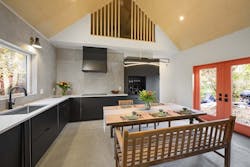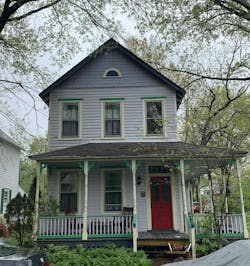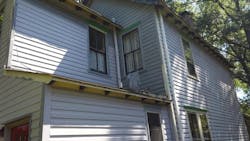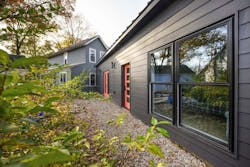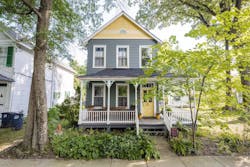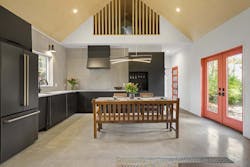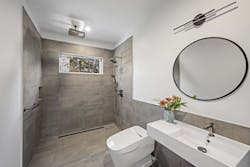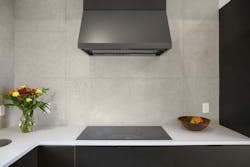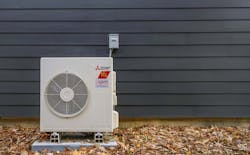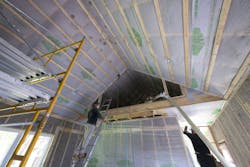Model ReModel 2022: A Case Study in Sustainable, Thoughtful Construction
After years of living in density, Greta Mosher announced one morning to her husband, “I’ll never have my own garden.”
The next day, the couple went to tour a promising home up for sale, yet Mosher’s eye was caught by a less promising listing nearby: a run-down 19th-century Victorian. It would need work, but there was potential.
The couple would go on to call that Victorian home for 27 years, and when discussions of aging and downsizing (and no longer enjoying the dusting of Victorian-era millwork) began, the two would fight with the idea of needing to leave their community. That came to become the guiding star of this year’s Model ReModel project.
Local Cabin John, Md.-based builder Symbi Homes would purchase the home, and CEO Nicole Tysvaer, VP of Production Matt Kulp, and Architect John Linam Jr's vision for the remodel would both maintain the historical character of the original home and keep the couple in their community by constructing an attached accessory dwelling unit.
Symbi chose to attach the accessory dwelling unit to the rear of the Victorian, designed with aging-in-place and universal design principles with an emphasis on wellness and energy efficiency. In addition, the original Victorian home will undergo a deep energy retrofit, meaning its energy consumption will be reduced by a minimum of 50%.
A Balance of Old and New
For the last six months, Pro Remodeler has followed the construction of the addition as its eighth annual Model ReModel project. The project scope includes one bedroom, one full bath, a kitchen, and a living area across the 825-square-foot addition.
While the Victorian character remains, the new addition creates a juxtaposition and balance with a modern exterior and interior. The addition features a simple silhouette, fixed with a modern metal roof by Sherwin-Williams, dark charcoal siding, and large black-framed windows and brightly colored doors by ProVia, featuring matching black door hardware from Ferguson Bath, Kitchen, Lighting Gallery.
Symbi achieves a clean modern aesthetic by using minimalist trim for the doors, windows, and corner boards, painted the same color as the siding.
"The Symbi aesthetic often leans towards a monotone, organic color palette with occasional pops of color," says Tysvaer. "I think we accomplished that here. I love the way the lap siding evokes the Japanese Shou Sugi Ban-style of charred wood but at a fraction of the cost."
The exterior of the Victorian received a facelift and underwent a creative restoration to ensure no lead paint particles would escape into the air. Symbi power washed the existing siding, applied a priming bonder from Sherwin-Williams, and lightly sanded, keeping most of the existing paint.
Symbi selected a deep green-gray paint for the siding, off-white trim, and bright aqua blue and yellow for accents, such as the classic fishtail gable.
"We love an eclectic mix of old and new in our remodeling projects with contrasting yet complementary color palettes,” says Tysvaer.
Comfort and Safety Through the Years
Symbi takes a symbiotic (hence “Symbi”) approach to construction, according to Tysvaer. Projects are made to be mutually beneficial to people and the planet, ensuring the elements of wellness, efficiency, and sustainability are met for both inhabitants and habitat.
For the interior design of the addition to ensure wellness, Symbi chose a biophilic design approach, incorporating natural elements such as raw plywood for the addition’s dramatic vaulted cathedral ceiling and a polished concrete floor, for example.
Thanks to several universal design elements, Greta Mosher and husband Steve Larrence will comfortably and safely age in place.
These elements include barrier-free entries, such as a pathway from the parking pad through entry doors into the suite, which also features wheelchair accessibility, ADA-compatible door hardware, keyless entries, and Wi-Fi-enabled smart lighting. Wider doors and hallways will exceed ADA recommendations of 32 inches wide and provide 36 inches of space.
In the bath, the couple will have access to a curbless shower and ADA-compatible plumbing fixtures from Ferguson, such as a toilet, wall-mounted sink, faucet, and shower controls. Symbi chose Mitsubishi Electric HVAC Trane US mechanicals for multiple layers of filtration and dehumidification. Ferguson also supplied the bath's dehumidistat controlled bath fan and home's ERV system.
“Building sustainable homes is just as much about sustaining the health and wellness of people, the inhabitants of our built environment, as it is about sustaining the health of our planet,” says Tysvaer.
Net Zero Knockout
One of the most impressive parts of this year’s Model ReModel is its energy transformation. Tysvaer’s goal for the Victorian and the addition was to reach net zero energy. This required a deep energy retrofit to the Victorian and solar panels, efficient mechanicals, and tight insulation in the addition.
A deep energy retrofit, according to the US Department of Energy, is designed to substantially reduce energy demands while increasing conservation measures and making improvements to indoor air quality.
With a deep energy retrofit, "homeowners get more bang for their buck than your typical renovation," says Tysvaer. "Retrofitting improves the comfort, health, and resilience of a home and also reduces energy use, which means that any additional costs of retrofit upgrades should pay for themselves over time. Plus, you are reducing the homes' reliance on fossil fuels, which has a positive impact on the environment."
To begin the retrofit, Tysvaer worked with a local green rater to identify the starting and ending Home Energy Rating System (HERS) Index score, which measures how well a home performs relative to an average cold-built home. The Victorian scored a whopping 188, making it 88% less efficient than the average home built today.
The target? A 94 HERS score, which includes the new addition.
With efficient products such as induction cooktops from Ferguson, 6.8 kW solar panel array, ProVia windows and doors, Greenfiber's Sanctuary insulation, Titebond sealant and caulks, and mechanicals from Mitsubishi, the home achieved a HERS score of -12, far exceeding the goal.
Insulation played a key role in the construction of the high-performance addition. Greenfiber’s R-21 Sanctuary blown-in cellulose insulation comes from recycled plant fibers and is carbon negative, meaning it absorbs carbon while keeping the addition tight. Symbi utilized continuous exterior insulation with R-5 rigid polystyrene foam on top of a water-resistant barrier. The contractor also used two layers of R-7.5 XPS rigid foam insulation vertically and R-10 EPS foam horizontally.
"This negative HERS score demonstrates that we can build to a very high-efficiency standard without significant cost increases, and our homeowners will pay next to nothing on their electricity bill as well,” says Tysvaer.
Mosher and Larrance will live comfortably and safely in their community with the added benefit of low energy bills, thanks to the symbiotic approach Symbi Homes took with Model ReModel 2022.
